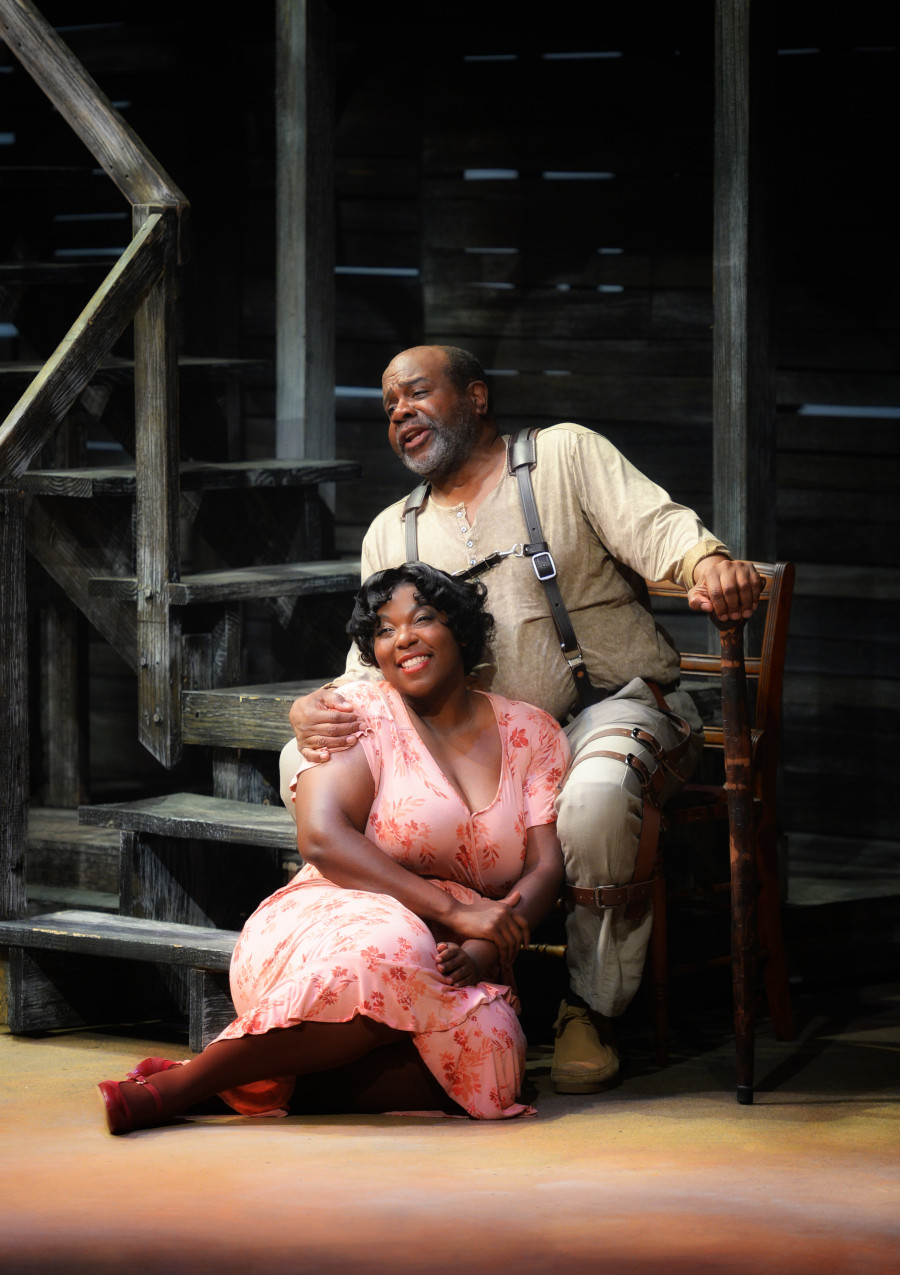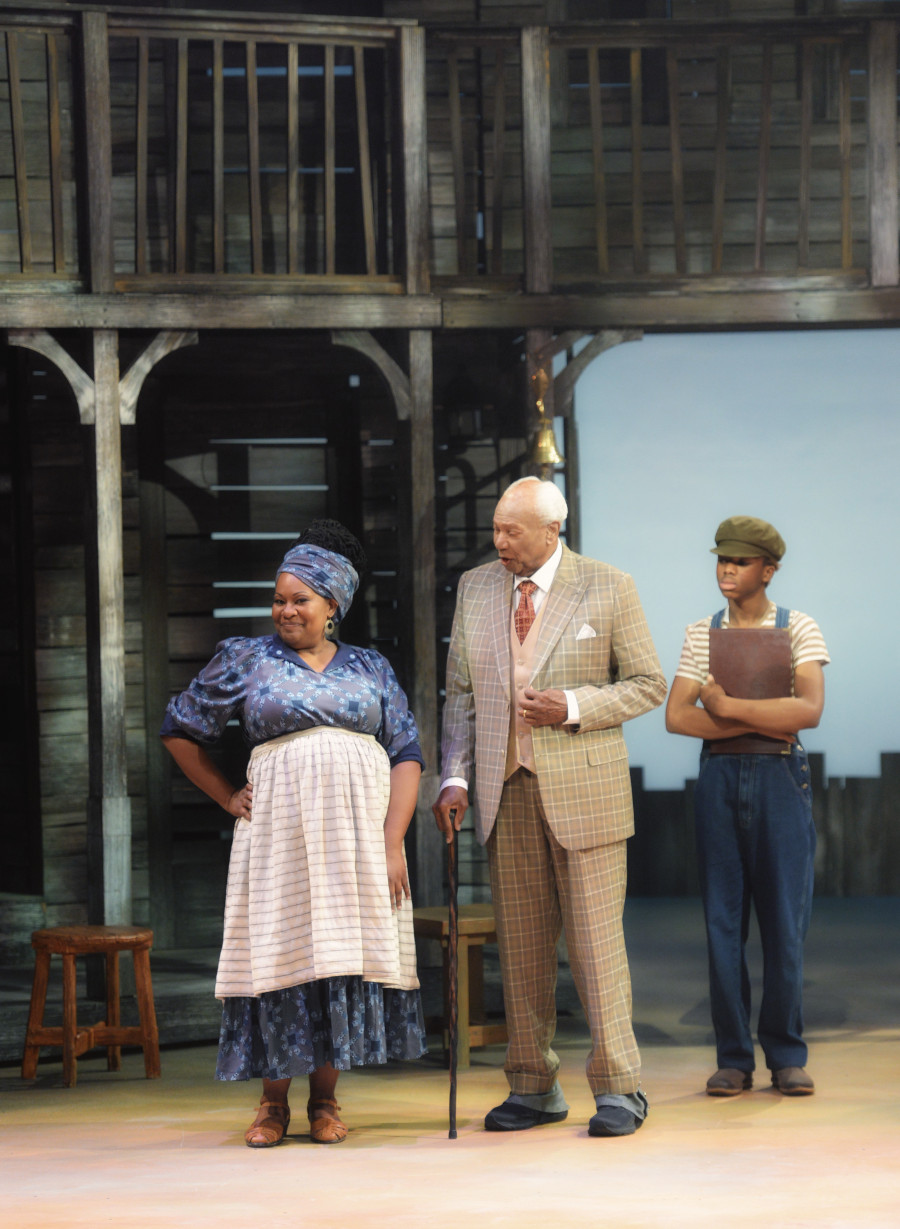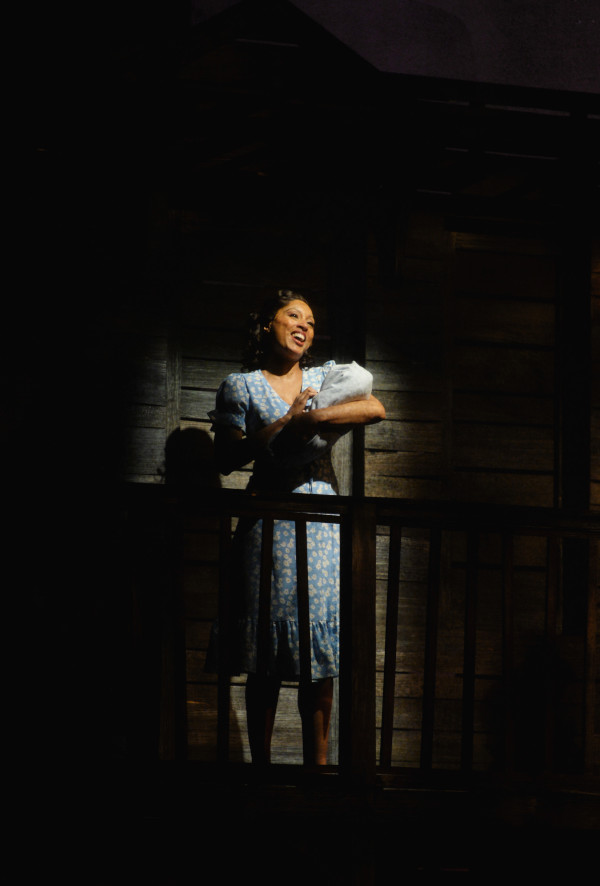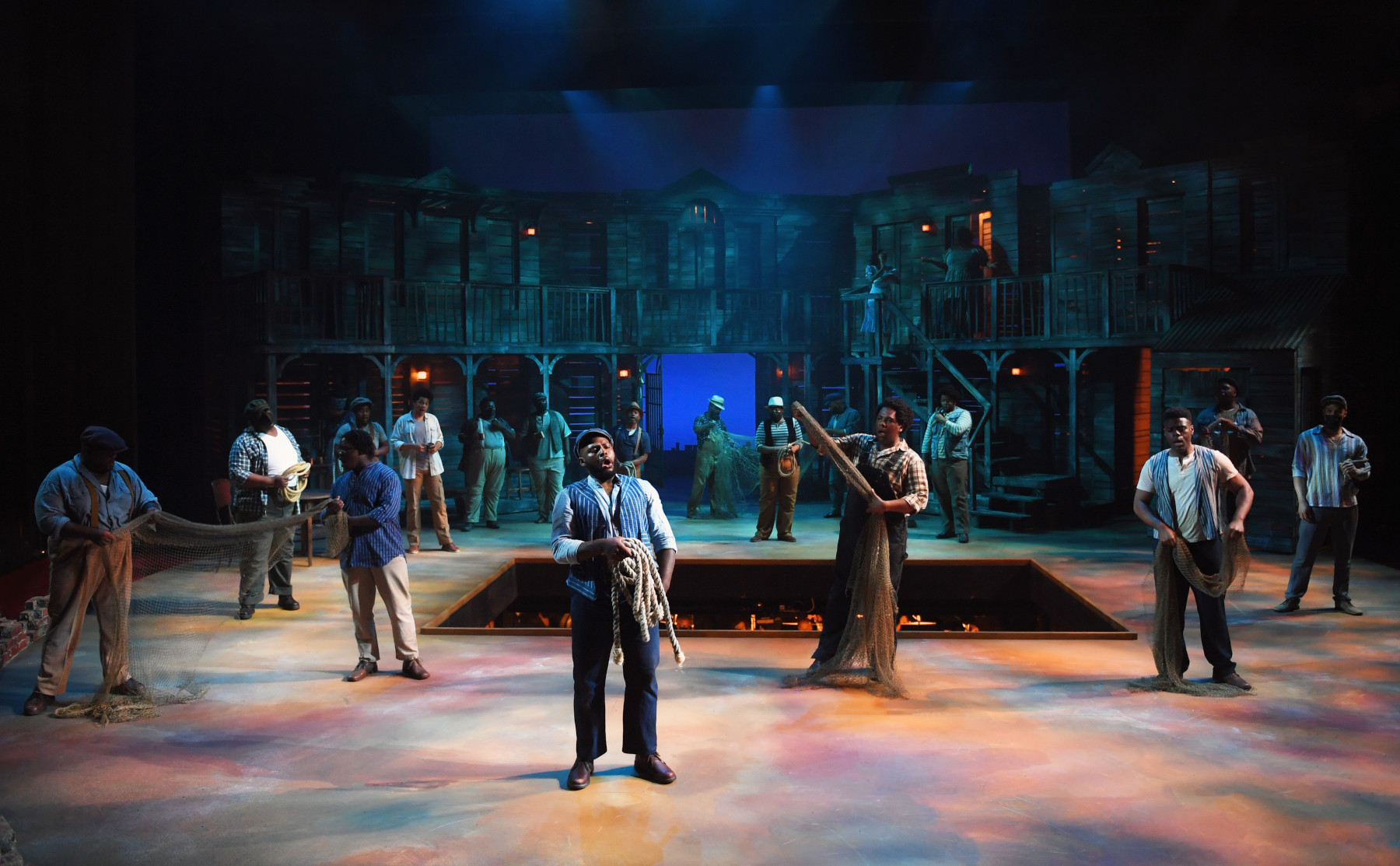How was Des Moines Metro Opera’s closing performance of The Gershwin’s Porgy and Bess a landmark event? Let me count the ways.
First, it marked the successful completion of DMMO’s uniformly excellent Fiftieth Anniversary Season. Fifty years! Bravi, bravissimi!
Second, it saw the great Iowan bass-baritone Simon Estes simultaneously making his DMMO debut and giving his final performance on an operatic stage. At eighty-four years young, Mr. Estes still had stage savvy galore that he displayed in a firmly sung, memorable cameo as the conniving Lawyer Frazier. It was quite an emotional moment at curtain call when he was presented a huge spray of roses to the roaring appreciation of the sold-out house. He is a giant among us. Bravo, bravissimo!
Third, it was proof positive of the tremendous value of the Frank R. Brownell III Apprentice Artists program. When COVID compromised the cast, the originally scheduled Porgy was capably replaced by young Artega Wright, thoroughly prepared, who saved the show; his vibrant, mellifluous bass-baritone handily encompassed the role’s demands. When he playfully limped, then spryly broke into a prance coming out for his call, he was overwhelmed with an ovation from audience and cast members the likes of which I have rarely heard. As it went on and on unabated, Mr. Wright teared up, and I confess I did too. Bravissimo, bravississimo!

Fourth, in a season that included many triumphant turns by supremely gifted vocalists, there were few moments of accessible ‘traditional’ arias in the other three operas on offer. Well, Porgy and Bess is chockfull of them from first to last! It contains world-famous melodies that were ravishingly performed by a world-class cast. This wildly popular score sold out the theatre for each scheduled performance and sent us home with a song(s) in our heart to cap the anniversary.
Many collaborators played an important role in the production’s success, not least of which is Tazewell Thompson and his inspired direction. The seasoned Mr. Thompson created telling character relationships, nurtured revelatory subtext, and devised well-motivated blocking. He utilized the entire playing space with good variety and commendable focus, such as when he placed the crap game in the center of the stage thrust. He was well served by his fight coordinator, Ron Piretti, who devised the several lethal looking encounters that inform the plot. Tazewell effortlessly moved the huge forces around the stage with a seasoned eye. Lisa Hasson’s polished choral forces were simply awesome.
Conductor Michael Ellis Ingram achieved exciting results from his assembled forces. The orchestra regaled us with joyous jazz licks and spirited melodic flights of fancy, rhythmic propulsion, and plangent laments in equal measure. Maestro Ingram drew richly detailed, diversely colored playing from DMMO’s fine musicians, and was an effective partner with his stellar vocalists. One observation: The large chorus was so spectacularly powerful that there were times when they were in full-throated cry on the apron and thrust, that the orchestra, disadvantaged below in the mid-stage pit, was momentarily eclipsed. Small matter, as this was overall a wholly satisfying, illuminating reading of the score.
Michelle Johnson sang masked as Bess, but nothing could mute her breathtaking (pun intended) performance. Ms. Johnson is possessed of a sparkling spinto instrument that she deployed with accuracy and insight. Whether delivering a limpid love song, sassy rejoinder, or heartfelt entreaty, she was always in total command of her creamy delivery and assured vocalism. At full volume in high flying phrases, or in hushed exchanges, she never faltered in her beautifully controlled vocalism. Moreover, she totally embodied the complexities of this conflicted character.

I did not think anyone could bring something fresh to the well-known punchlines of “It Ain’t Necessarily So.” I was wrong. The dynamo that is Jermaine Smith gave an authoritative interpretation as Sportin’ Life. He displays no cute musical comedy sensibility in this key role, no, he knows exactly how willfully evil he is. His chronic, troubled laugh covers up a multitude of malintent. He is a villain we love to hate, no more so than in the afore-mentioned song at the picnic on Kittiwah Island. In an inspired interpretation, Mr. Smith challenged the chorus to repeat improvised vocal riffs that are variations on the original line. It was electrifying. His interpolations in “There’s A Boat That’s Leaving” were exciting throwbacks to the practice of Baroque ornamentation.
Norman Garret was a colossal Crown. Not only is he an imposing and (in context) dangerous physical specimen, his booming, brooding baritone perfectly communicated his deadly serious intentions. “A Red-Headed Woman” was delivered with zesty menace. Leah Hawkins contributed her own star turn as an intense Serena. “My Man’s Gone Now” was incisively delivered, pulsating with heart-on-sleeve emotion, her sizable soprano throbbing with wondrously controlled heartbreak and loss. Ms. Hawkins was a potent presence throughout the performance, creating a consistently pious character, and singing with impassioned allure. As her husband Robbins, Errin Duane Brooks, made the most of his brief stage time by showing off a searing, incisive tenor of considerable heft.
Soprano Jacqueline Echols got the proceedings off to a melodious start with her limpid, leisurely rendition of the opera’s most familiar tune, “Summertime.” The sweetness of her effortless delivery was in evidence throughout the range. Lucia Bradford’s wise and sassy Maria was a tour de force to be reckoned with, both in her assured stage presence and her confident singing. Her mezzo-soprano has a robust, golden presence, especially in its rock-solid lower register. Ms. Bradford made a fine effect in her extended rap solo, “I Hates Yo’ Struttin’ Style,” a minutely choreographed staging in which she threatened Sportin’ Life with a carving knife.

Blake Denson’s Jake made the most of “A Woman is a Sometime Thing” thanks to his responsive, cultured baritone and its commanding upper register. His is an uncommonly rich instrument that also shone in “It Take a Long Pull to Get There.” David Morgans Sanchez as Mingo dominated the craps scene with an ebullient spinto tenor that is sturdy, pleasantly grainy, and very personalized.
In a thorough, illuminating pre-show talk, Resident Opera Lecturer Joshua Borths opined that the opera should perhaps be titled Catfish Row since all things considered it is about community and supporting each other. With that in mind, every person on that stage brought a particular dedication, dramatic commitment, and admirable vocal talent to create the community mosaic that informs Porgy and Bess. Please read the complete cast list below and know they were all excellent, singly, and together.
And speaking of Catfish Row, DMMO veteran set designer R. Keith Brumley created a two-story semicircle of wooden rowhouses that was as warmly weathered as it was eminently functional. The courtyard gate was a great focal point up center, and placing Porgy’s house down left was another wise choice for staging some key plot moments. A beautifully mottled stage floor in earth tone hues was a comforting unifying element. While the housing occupied the proscenium area, other locales were suggested by moving the cast onto the thrust and backing them on Kittiwah Island with the attractive show curtain, a huge impression of jazz players evoking the style of Thomas Hart Benton; or creating an indoor hall by flying in a sturdy wall just behind curtain line fashioned with wooden slats, with cracks allowing some light to get through.

Lighting designer Robert Wierzel used all the skills in his considerable artistic arsenal to create an astonishingly varied parade of effects. It goes without saying that Mr. Wierzel does his usual fine work delineating times of day, and utilizing well-considered specials, but I was also struck this time by his effective uses of backlighting, especially in the scene where the cast was basked in a blue glow as they held lighted candles. Too, he showed considerable skill in keeping darker complected performers well defined with responsive illumination.
Kellen M. Eason devised the simple and effective make-up and hair-design, no mean feat considering the size of the cast. Harry Nadal’s costume design was spot on, from Crown’s thuggy black ensemble to Sportin’ Life’s pin-striped dandy suit to the many, character-specific work clothes and patterned day dresses of the local denizens.
Mr. Nadal scored big with his treatment of Bess, who first appeared as a willful floozy in a bright red dress. After she unites with Porgy, he attires her in modest pinks. Late on, as she seems to resist Sportin’ Life’s entreaties during “There’s a Boat That’s Leaving” she holes up in Porgy’s house. But the happy dust he slides under the door has its effect and when Bess bursts out to join him in New York, she stuns us by reverting to the shocking red dress for her exit.
At the end of such an eventful season that capped a remarkable fifty years in operation, I couldn’t help but muse on the many fine, even definitive performances I have been privileged to experience at Des Moines Metro Opera over the years. While the Fiftieth is in the history books now, I am already looking forward to the Fifty-first, and the brand new experiences this enterprising company are sure to present with their usual attention to detail, loving care, and superior artistry.
James Sohre
Porgy and Bess
By George Gershwin, Dubose and Dorothy Heyward, and Ira Gershwin
Cast and production staff:
Clara: Jacqueline Echols; Mingo: David Morgans Sanchez; Sportin’ Life: Jermaine Smith; Jake: Blake Denson; Serena: Leah Hawkins; Robbins: Errin Duane Brooks; Jim: Anthony D. Anderson; Peter: Roland Hawkins II; Maria: Lucia Bradford; Porgy: Artega Wright; Crown: Norman Garrett; Bess: Michelle Johnson; Detective: Richard Cordova; Lily: Imara Miles; Policeman: Jonathan Patton; Undertaker: Patrick Blackwell; Annie: Gedeane Graham; Lawyer Frazier: Simon Estes; Nelson: Sankara Harouna; Strawberry Woman: Lynnesha Crump; Crab Man: Demetrious Sampson, Jr.; Coroner: Kellen Schrimper; Second Policeman: Sam Mathis; Conductor: Michael Ellis Ingram; Director: Tazewell Thompson; Set Design: R. Keith Brumley; Costume Design: Harry Nadal; Lighting Design: Robert Wierzel; Make-up and Hair Design: Kellen M. Eason; Fight Director: Ron Piretti; Chorus Director: Lisa Hasson
Above photo: Kevin Deas (center) as Porgy with chorus
All photos by Duane Tinkey